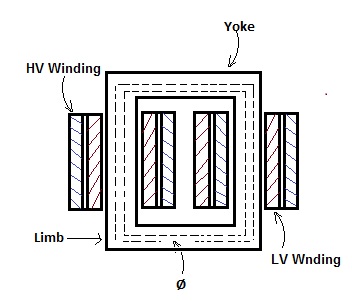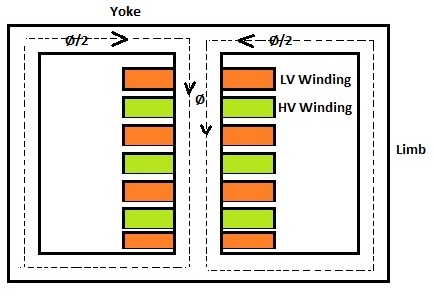The main difference between Core type and Shell Type Transformer is the constructional difference of their core and winding arrangement. In core type transformer, the magnetic core consists of two limbs and two yokes whereas in Shell type transformer, there are three limbs and two yokes.
Core Type Transformer:
In core type transformer, the HV (High Voltage) and LV (Low Voltage) winding are wound on both the limbs. The winding are wound in such a manner to minimize the leakage flux. For this purpose, first LV winding is wound over which HV winding is wound. This also have advantage of lesser insulation requirement for having insulation between the LV winding and the core. Figure below shows a simple diagram of core type transformer.

Shell Type Transformer:
In Shell type transformer, the winding are interleaved or sandwiched on the central limb as shown in figure below.

The LV winding is placed near the yoke and its size is made half of that of other winding. Since the winding is wound on the central limb, total flux Ø flows through the central limb whereas in yoke only half of the total flux i.e. (Ø/2) flows.
There are many differences between the core type and shell type transformer from design and operational aspect.
Difference between Core type and Shell type Transformer:
| Sr. No. | Core Type Transformer | Shell Type Transformer |
| 1) | In Core type transformer, the core consists of two limbs are two yoke. | In Shell type transformer, the core have three limbs and two yokes. |
| 2) | Total magnetic flux Ø flows through the entire core. This means that there exists a single magnetic circuit. | Half of the total flux Ø flows through the yoke and outer limbs i.e. there are two magnetic circuits. Total flux Ø only flows in the central limb. |
| 3) | The HV and LV winding in Core type transformer are concentric. LV winding is placed on the core. This LV winding is then surrounded by HV winding. | HV and LV winding in shell type transformer is interleaved or sandwiched on the central limb. |
| 4) | This type of transformer is used for high voltage and high power applications. | It is suitable for low voltage and low power applications. |
| 5) | The conductor material requirement for winding is more as compared to shell type transformer. | The conductor material requirement is less. |
| 6) | Iron requirement for core construction is less. | The iron requirement for core construction is more as compared to core type transformer. |
| 7) | Core loss is more due to flow of total flux through the entire core. | Core loss is less as compared to shell type transformer. This is due to the fact that only half of the total flux flows in the core. |
| 8) | More copper conductor requirement leads to more ohmic loss. | Ohmic loss is less as conductor requirement is less. |
| 9) | Total loss in core type transformer is thus more than the shell type transformer. | Total losses (Core+Ohmic loss) is less. |
| 10) | The overall efficiency is less due to more losses. | The overall efficiency of shell type transformer is more than the core type transformer. |
| 11) | Core type transformer is more popular and widely used. | – |